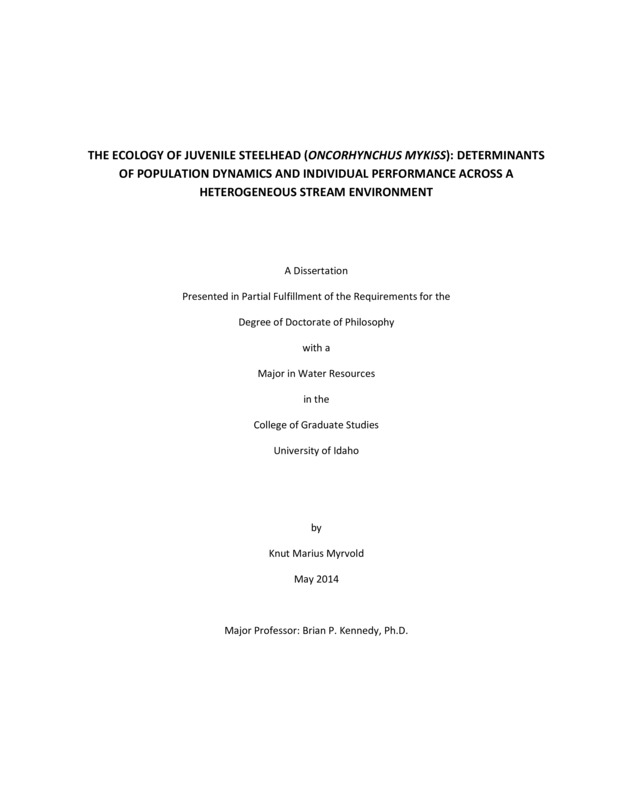The ecology of juvenile steelhead (Oncorhynchus mykiss): determinants of population dynamics and individual performance across a heterogeneous stream environment
Myrvold, Knut Marius. (2014). The ecology of juvenile steelhead (Oncorhynchus mykiss): determinants of population dynamics and individual performance across a heterogeneous stream environment. Theses and Dissertations Collection, University of Idaho Library Digital Collections. https://www.lib.uidaho.edu/digital/etd/items/myrvold_idaho_0089e_10313.html
- Title:
- The ecology of juvenile steelhead (Oncorhynchus mykiss): determinants of population dynamics and individual performance across a heterogeneous stream environment
- Author:
- Myrvold, Knut Marius
- Date:
- 2014
- Keywords:
- Aquatic Ecology Idaho Population Salmonid
- Program:
- Water Resources
- Subject Category:
- Ecology; Environmental science
- Abstract:
-
Identifying the processes by which populations are governed and the conditions under which they are operant is a primary interest in ecology and has obvious relevance for management. Anadromous Pacific salmonids represent a particularly imperiled taxon with large conservation interest, especially in the Columbia River Basin, USA. This project concerned the juvenile rearing stage of a population of threatened Snake River steelhead (
Oncorhynchus mykiss ) in the Lapwai Creek watershed, Idaho. The system is characterized by hot and dry summers, heterogeneous habitat conditions, and substantial differences in densities both within and among tributary streams. The primary goal of this research was to identify mechanistic linkages between individual- and population-level demographic parameters and their environment, and to understand how population processes operate to shape individual performance.The results showed that temperature-induced energetic costs posed constraints on individual growth, suggesting that energetic cost can offset the competitive advantages of large body size when food is a limiting factor. Secondly, density-dependent regulation of cohort size occurred under certain conditions but was not ubiquitous, suggesting population sizes below carrying capacity. The strength of the regulation was explained by environmental conditions and temperature. Thirdly, despite overall low densities, density dependence was manifested in depressed individual growth rates. Growth rates in both cohorts were negatively related to the total population densities, but were inconsistently affected by the densities of the other cohort. Fourthly, habitat-based controls on densities were operant across spatial scales. Whereas watershed topography and discharge regime best described the variation in subyearling densities, yearlings were better described by channel hydraulics. Finally, site fidelity was overall low, suggesting that a large proportion of the individuals were not territorial, and that the propensity to stay was better predicted by habitat factors than biotic factors.
In conclusion, these results show an overall strong abiotic control on juvenile steelhead abundance in the study system, but the strength of these controls to vary substantially across time and space. The subsequent strength of the density-dependent processes depended on these abiotic controls. The combined effects of these abiotic and density-dependent controls constrained and shaped individual growth performance and movement decisions.
- Description:
- doctoral, Ph.D., Water Resources -- University of Idaho - College of Graduate Studies, 2014
- Major Professor:
- Kennedy, Brian P.
- Committee:
- Fremier, Alex; Caudill, Chris; Nislow, Keith
- Defense Date:
- 2014
- Identifier:
- Myrvold_idaho_0089E_10313
- Type:
- Text
- Format Original:
- Format:
- application/pdf
- Rights:
- In Copyright - Educational Use Permitted. For more information, please contact University of Idaho Library Special Collections and Archives Department at libspec@uidaho.edu.
- Standardized Rights:
- http://rightsstatements.org/vocab/InC-EDU/1.0/

